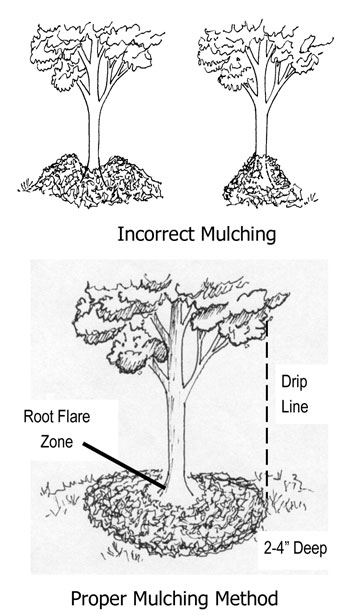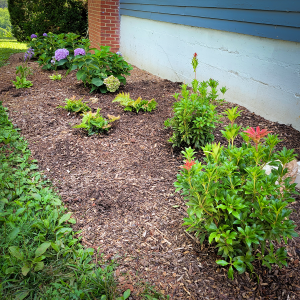Benefits of Proper Mulching
Good tree maintenance is common sense – it is what trees need to flourish in nature. In the wild, the forest floor is naturally covered with a layer of decomposing leaves, twigs and other plant material. In urban settings, the most common mulch is made of wood chips of varying types and sizes.

Properly Applied Mulch:
· Impedes growth of weeds and grass that compete with tree roots robbing them of water and nutrients.
· Conserves soil moisture by slowing down the evaporation of water from the soil surface helping to retain more water for root use for longer periods of time.
· Protects the trunk from mower/ weed whacker damage by eliminating the need to mow or trim immediately around the trunk.
· Reduces soil compaction by reducing foot and vehicle traffic allowing roots to breathe.
· Moderates soil temperature keeping the roots cool in the summer and warm in the winter there-by reducing stress.
· Improves soil fertility as it decomposes.
· Prevents erosion.
Mulch Out, Not Up
· No mulch volcanos. Mulch should not be deeper than 2-4 inches. If using finely textured or double shredded mulch, use 1-2 inches because these materials allow less oxygen to the root zone.
· Not against the trunk – keep all mulch 3-4 inches away from the trunk of the tree or shrub, allowing the root flare zone to show just above ground level.
· Spread the mulch out to the tree’s drip line if possible. Remember that the drip line moves out as the tree grows. (see “How Roots Really Work” drawing.)
· Other Tips:
If a “fresh” look is desired each season, take some of the old mulch away before adding a new layer to reach the 2-4” depth. Just lightly raking the existing mulch can achieve a finished look. Applying new material over old in successive years is the same as applying a too deep layer all at once!
Remember: Keep the bark dry and the roots moist.
Problems Associated With Over-Mulching or Incorrect Mulching
Incorrect mulching is a waste of time and money and is quickly becoming the number one cause of death of trees and shrubs. Over-mulching, with mulch piled high, directly against the stems or trunks, smothering the root flare zone; or with very deep mulch covering part or all of the root area cause:
— Root Suffocation/ Root Rot – Repeated or deep applications of mulch cause waterlogged soil by slowing water loss through evaporation. Roots must “breathe”, taking in oxygen. When oxygen levels drop, root growth declines then they die, making it impossible for the plant to take up water and nutrients, leading to death.
— Inner Bark Death – The living tissue (phloem) just inside the outer bark must be able to freely exchange oxygen and carbon dioxide. Mulch piled high onto the trunk decreases gas exchange, killing the inner bark and then the roots, which can no longer receive food from the leaves.
— Rodent/ Insect Chewing – Deep layers of mulch against the trunk provide a perfect habitat for these pests. If chewing is extensive (more than 50% of the circumference) or “girdles” the entire tree, little can be done to save the tree.
— Fungal and Bacterial Diseases – These can grow and reproduce in the thick, moist mulch next to the trunk, gaining entry into the stressed, decaying bark. Once established, cankers caused by these diseases, can encircle the tree, killing the inner bark, starving the roots and killing the plant.
— Excessive Heat – Thick layers of mulch begin to decay and can produce heat (similar to composting).
Waterproof Layers – Thick layers of certain mulches can create impervious surfaces that do not allow water to reach to roots, especially during drought. Roots dehydrate and die, killing the tree.
Symptoms of Decline
Death from over-mulching is gradual, with symptoms sometimes taking 3-5 years to express themselves. It starts with the decline of plant vigor and rate of growth.
· Off-color leaves (pale or marbled)
· Abnormally small leaves
· Poor twig growth
· Die-back of older branches
· Rotting, pealing trunk bark under the mulch are classic signs that get worse every year, and at the point they are recognized, it is too late to apply corrective measures.
Dos Amigos will care for your trees from planting and installation to mulching and pruning for healthy growth. Dos Amigos has more than 40 years of experience pruning and caring for trees and shrubs.
Soucres: Chris Carlson, Dir. Hort. Tech., Kent State U.; Diane Relf, Environmen. Hort. VA Coop Ext, VA Tech; Dr. Robt. Nuss, Hort. Penn State U.; Donald Rakow, Cornell Univ. Drawings from International Society of Arboriculture Training Manual or drawn by Barbara Lupfer, Certified Arborist..
Compiled and edited by Barbara Lupfer, Certified Arborist


